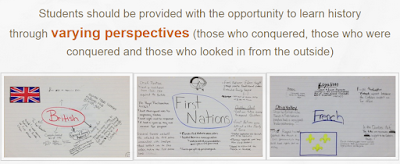Put Yourself In Their Shoes… Does The Adolescent Brain Allow That?

– What happened? When did it happen? Why did it happen? (History)
– Where did it happen? What was there then? What is there now? (Geography)
– Why did that area look like that? How did the Earth influence what was happening? (Geology)
It should come as no surprise that history (and in the broader curriculum sense: social studies) is my favourite content-area to teach. While I was initially hired on as a science and math teacher, a future move into this area was discussed. With that being said, I am very happy to know that I will be returning from Mat leave to a position that includes at least:
– Grade 11 Canadian History
– Grade 10 Geography
– Grade 8 Social Studies
One aspect of this content-area that is very important to me is the ability for my students to take into account that one situation can be interpreted very differently by different groups of people based on their perspective at any given time. In fact, this is something that I include in my personal philosophy of education:

This is something that students are able to grasp with varying levels of success. I find that sometimes students are able to only identify facts about specific cultural groups that were involved (ex: Tecumseh was a First Nations leader during the War of 1812) while sometimes they are able to more accurately critique what the situation would have been like for that cultural group (ex: Tecumseh chose to side with the British due to the fact that American settlers had treated their allies poorly in the past and was concerned that they would take over his ancestral land). More often than not, however, my students fit into the earlier category rather than the later.
I recently came across a TED talk by Sarah-Jayne Blakemore that shed some light on why my students sometimes have difficulty looking at other people’s perspective. She argues that the prefrontal cortex of the brain, which is responsible for things like decision making, social interactions, understanding others, etc develops the most during adolescence. She has completed several studies that analyze behavioural tasks at different ages and has found that there is a significant improvement in taking into account another person’s perspective in order to guide behaviour between the period of later adolescence and adulthood. Essentially, the adolscent brain is simply not ready to effectively gauge another person’s perspective until they are already out of high school and into early adulthood. The video itself is about 14 minutes in length and I definitely found it worth watching; it provided some insight about my students’ development that will help me plan my lessons more appropriately in the future.